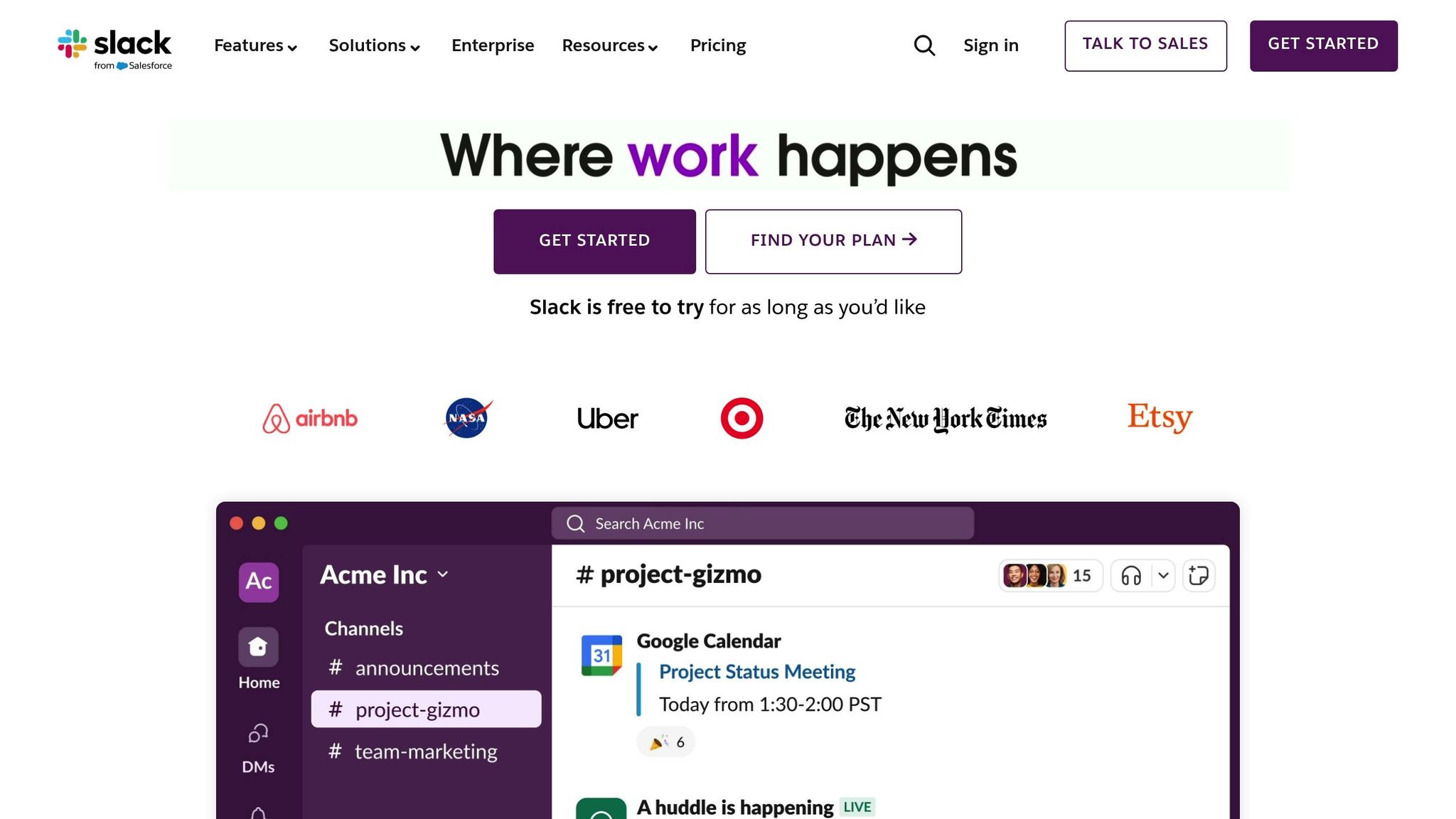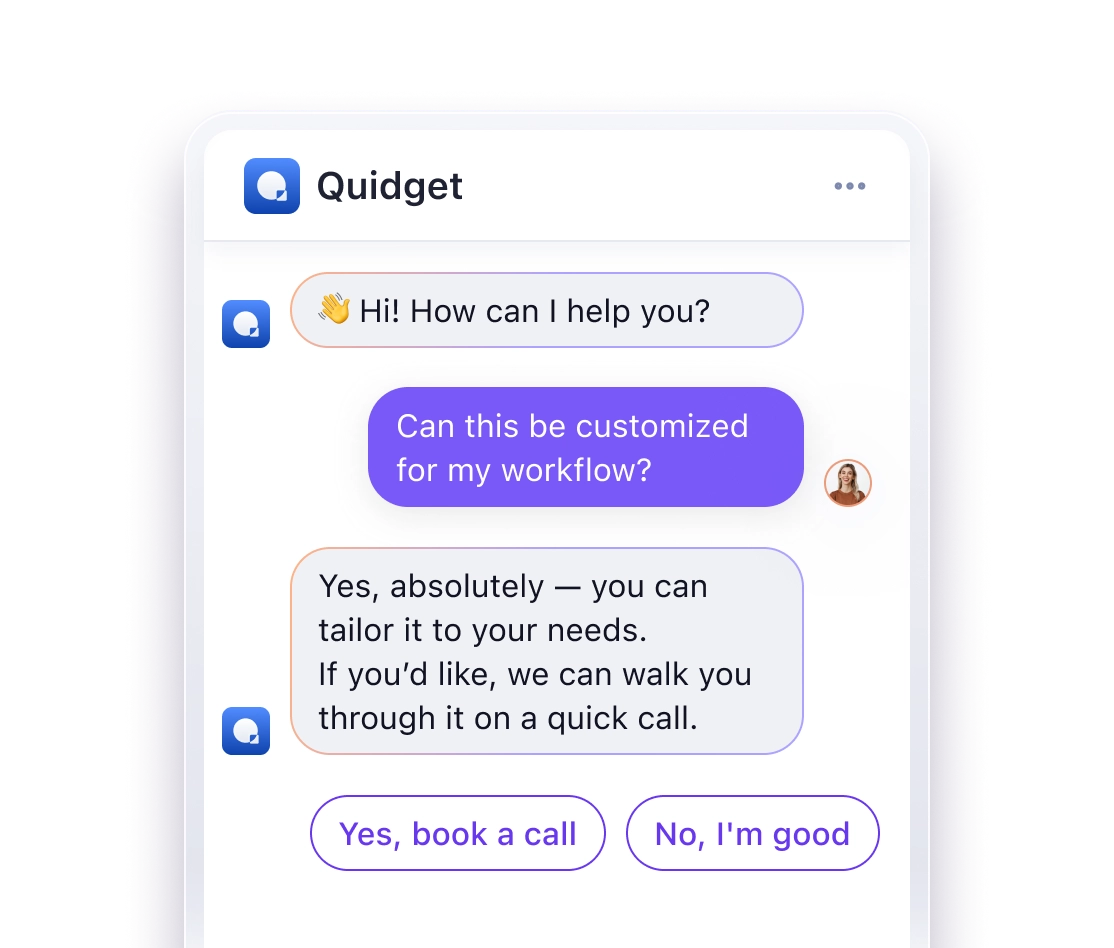AI chatbots in Slack can save you time by automating repetitive tasks. From summarizing conversations to scheduling messages and integrating with business tools, these bots streamline workflows and improve team efficiency. Here’s what you need to know:
- Time Savings: Free up 97 minutes per week by automating tasks like message scheduling and file searches.
- Productivity Boost: Teams report a 47% increase in productivity with AI chatbots.
- Key Features: Summarize threads, answer FAQs, manage permissions, and integrate with apps like Salesforce and Zendesk.
- Security: Slack AI ensures data privacy, with no sharing or training on customer data.
Whether you’re in HR, sales, or IT, Slack AI chatbots can handle routine tasks, allowing your team to focus on more important work. Ready to get started? Learn how to set up and maximize these tools below.
How to automate your work with Slack

Understanding Slack AI Chatbots
A Slack AI chatbot acts as a digital assistant, using natural language processing to handle routine tasks and improve internal communication within your Slack workspace. It works directly within Slack’s secure platform, managing queries and automating workflows seamlessly.
How They Help Businesses
Teams have reported a 47% boost in productivity. Here’s why these chatbots stand out:
- Instant Knowledge Access: The chatbot searches through public conversations and shared files to deliver quick answers, cutting down on manual searches.
- Time-Saving Tools: It can summarize channels and threads, create daily recaps for key channels, answer common questions, and assist with scheduling meetings and sending reminders .
- Built-In Security: These tools run on Slack’s secure infrastructure, ensuring compliance while keeping customer data private and away from external language model providers.
These features translate into real-world improvements across various departments.
Where Businesses Use Them
Different teams benefit in unique ways. For example, HR and training teams use chatbots to onboard new employees, making it easier for them to learn company policies and procedures. This reduces training time and ensures a consistent onboarding process. At Wayfair, automation helped teams save hours by eliminating repetitive tasks.
Sales teams use AI to gather market insights and compile case studies, speeding up proposal creation. Research shows 87% of users experience better collaboration, and 80% of Slack workflows are built by non-technical staff .
Additionally, businesses can manage file access permissions, enable PII encryption, and opt for private language model providers to secure sensitive data. By integrating these tools into everyday tasks, teams can work more efficiently and meet their goals with ease.
Setting Up a Slack AI Chatbot
1. Choose Your Chatbot Tool
Decide which type of chatbot fits your needs. Slack’s built-in features are great for simple tasks, while third-party tools can handle more complex automation.
| Type | Best For | Limitations |
|---|---|---|
| Rule-based | Basic FAQs and straightforward tasks | Struggles with custom or unique queries |
| AI-driven | Handling complex conversations and adapting over time | Needs high-quality data and regular updates |
| Hybrid | A combination of basic and advanced tasks | – |
For example, Quidget provides a hybrid solution with pre-built templates for tasks like customer support and sales. It also allows you to train the bot using your own data. Quidget supports multiple languages and integrates with tools like Zendesk and Calendly.
Once you’ve picked your chatbot, follow the steps below to integrate it with Slack.
2. Connect the Bot to Slack
Start by creating a new Slack app and take note of these credentials:
- App ID
- Access Token
- Bot User OAuth Token
Next, navigate to the OAuth & Permissions section and assign these bot permissions:
- app_mention: Allows the bot to respond when mentioned.
- message.im: Enables direct messaging functionality.
- team_join: Lets the bot welcome new members.
After assigning permissions, click "Install App" and authorize it for your Slack workspace. Be sure to copy the Bot User OAuth Token – you’ll need it for the next steps.
3. Configure Responses
Set up your chatbot to respond to common questions and tasks. For example, you can program it to handle:
- FAQs, such as office WiFi details or company policies.
- Triggers like:
!stagingfor server info.!officemapsfor desk locations.!colorsfor brand color codes.
Test everything in a private Slack channel first. This ensures you can tweak and adjust the bot without disrupting others.
Once you’re happy with the setup, your chatbot is ready to take on daily tasks and improve team efficiency.
sbb-itb-58cc2bf
Top Slack AI Chatbots Compared
Let’s break down the differences between Slack’s built-in tools and third-party AI solutions to see which might work best for your needs.
Slack’s Built-in vs. External Tools
Slack’s built-in AI tools are great for basic tasks, but third-party solutions bring more advanced capabilities to the table. Here’s a quick comparison:
| Feature | Slack Built-in AI | Third-party Solutions |
|---|---|---|
| Core Functions | Message summarization, search, recaps | Custom AI assistants, workflow automation |
| Data Sources | Internal Slack data only | External sources + integrations |
| Language Support | English, Spanish, Japanese | Varies (e.g., LiveChatAI supports 95 languages) |
| Security | Runs on Slack infrastructure | Varies by provider |
| Pricing Model | Add-on to Pro/Business+/Enterprise plans | Subscription per tool |
For example, LiveChatAI resolves 82% of customer queries, while Saay improves deal visibility by 15–20%. Among these tools, Quidget is a standout option for its flexibility and multilingual support.
Quidget‘s Key Features

Quidget offers a range of features that make it a strong choice for integrating AI into Slack:
- Integration Options
Works seamlessly with tools like Zendesk and Calendly. It also supports platforms like WhatsApp, Slack, and Telegram, and provides API access for custom workflows. - Customer Support Capabilities
Handles up to 80% of routine customer questions, supports over 45 languages, and ensures complex cases are smoothly transferred to human agents.
With these capabilities, Quidget is a dependable solution for enhancing Slack with AI-driven support.
Common Workflow Automation Tasks
Help Desk Automation
IT support teams can lighten their workload by automating routine help desk tasks. For instance, when employees submit support requests through Slack, an AI chatbot can:
- Automatically reset passwords and unlock accounts
- Handle access and asset requests
- Manage user provisioning and suspension
- Direct users to relevant troubleshooting guides
Interestingly, 70% of users prefer to report support issues through Slack. This kind of automation frees up valuable time for support teams.
Team Message Automation
Chatbots aren’t just for IT – they also improve team communication. Automated workflows streamline tasks like meeting scheduling, updates, and task assignments. For example, the DSR Bot allows customer success managers to use a simple slash command to connect directly to Salesforce, speeding up request handling.
Here’s how teams use automation:
- Meeting Management: Chatbots schedule meetings, send reminders, and share agendas.
- Project Updates: Automated daily recaps keep everyone informed.
- Task Distribution: Bots assign tasks based on team members’ workloads.
Take Trivago as an example. By using Slack automation, they achieved a 24% faster time to get employees fully productive.
"Slack really helps to facilitate culture at the company… and allows everybody who needs to be involved to be collaborating and accessible".
Sales Process Automation
Sales teams also benefit from Slack-based automation. For instance, new leads can trigger a chatbot to share detailed lead info, let reps manage leads with a single click, and update the CRM automatically.
Contract approvals are another area where automation shines. With one system, sales reps can submit contract review requests in Slack, and the process works like this:
- Legal teams get instant notifications with all necessary details.
- Approvers can respond directly in Slack.
- The CRM updates automatically with the final decision.
This has reduced the time spent on admin tasks by 35%, giving sales teams more time to focus on building client relationships.
Tips for Successful Chatbot Use
Improving Answer Accuracy
Clear, straightforward questions lead to better answers. For instance, instead of asking, "Can you tell me about translation requests?" try asking, "How do I request content translations?" Simple "What" or "How" questions often yield more precise responses.
Here are some ways to enhance your chatbot’s accuracy:
- Set Clear Knowledge Parameters
Enrich the chatbot’s knowledge base with company documentation and FAQs to ensure it provides relevant answers. - Use Block Kit Components
Leverage Slack’s Block Kit blocks to structure responses consistently. This makes it easier for users to find the information they need. - Add Source Attribution
Include references to original Slack messages or documentation in responses. This not only builds trust but also allows users to verify the information independently.
Once you’ve fine-tuned your chatbot’s responses, it’s essential to keep an eye on its performance.
Checking Performance
Monitor key metrics like response accuracy, user engagement, and response times. A good monitoring system should include:
- User Feedback Collection: Add reaction buttons to let users rate responses.
- Engagement Tracking: Keep track of how often users interact with the chatbot.
- Handoff Analysis: Measure how frequently conversations are escalated to human agents.
"Trust is our number one value, and that starts with transparency. Our customers deserve a crystal clear explanation of how we use – and, more importantly, how we don’t use – customer data to provide the best possible Slack experience." – Slack
While monitoring performance, don’t overlook the importance of safeguarding data.
Data Security Steps
Protecting sensitive information requires strong security measures. Here’s how to ensure data safety:
- Set up access controls tailored to different user groups.
- Use enterprise key management to handle sensitive data.
- Implement data loss prevention tools.
- Enable data residency controls when necessary.
For companies managing customer data, regular security audits and compliance checks are essential. Slack AI messages can also be made ephemeral – vanishing after viewing without being stored on devices or servers.
Conclusion
AI chatbots in Slack are transforming team collaboration. Companies using these tools have reported measurable gains in both efficiency and productivity.
Take QuickBooks, for example. After integrating their custom Slack bot, they managed to resolve support cases 36% faster, saved 9,000 agent hours per year, and boosted their net promoter score by 12%. Similarly, Wayfair’s engineering team uses AI-driven conversation summaries to streamline incident analysis, cutting down investigation times significantly.
The advantages don’t stop at time savings. Research shows that combining AI tools with Slack can lead to a 28% increase in time saved through automation. This is especially important for businesses aiming to stay competitive, with nearly half (47%) of small businesses surveyed agreeing that adopting AI is crucial for maintaining their market position.
For companies ready to explore this technology, tools like Quidget make it easy. With a setup process that takes just 2 minutes, no coding required, and a free trial that doesn’t ask for a credit card, businesses can quickly see how AI automation fits into their operations.
Experts also stress the importance of clear guidance when introducing AI. Christina Janzer notes:
"Lack of clear guidance on AI may prevent employees from trying it. Start with guidelines on how AI can be used at work."
The takeaway is simple: AI chatbots are a powerful way to improve workplace efficiency.



